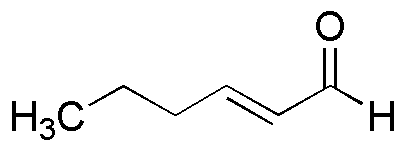trans-2-Hexen-1-al is widely utilized in research focused on
- Flavor and Fragrance Industry: This compound is valued for its green, fresh odor, making it a popular choice in the formulation of perfumes and food flavorings. Its natural scent profile can enhance the sensory experience of products.
- Aromatherapy: Due to its pleasant aroma, trans-2-Hexen-1-al is used in essential oils and aromatherapy products, promoting relaxation and well-being. It can be blended with other oils to create calming atmospheres.
- Agrochemical Applications: This chemical acts as a plant volatile, which can attract beneficial insects for pest control. Its use in agriculture can help improve crop yield by promoting natural pollination.
- Research in Organic Synthesis: It serves as an important intermediate in organic synthesis, allowing chemists to create more complex molecules. This application is crucial in pharmaceuticals and materials science.
- Food Preservation: The compound exhibits antimicrobial properties, making it useful in food preservation. It can help extend the shelf life of various food products by preventing spoilage.
General Information
Properties
Safety and Regulations
Applications
trans-2-Hexen-1-al is widely utilized in research focused on
- Flavor and Fragrance Industry: This compound is valued for its green, fresh odor, making it a popular choice in the formulation of perfumes and food flavorings. Its natural scent profile can enhance the sensory experience of products.
- Aromatherapy: Due to its pleasant aroma, trans-2-Hexen-1-al is used in essential oils and aromatherapy products, promoting relaxation and well-being. It can be blended with other oils to create calming atmospheres.
- Agrochemical Applications: This chemical acts as a plant volatile, which can attract beneficial insects for pest control. Its use in agriculture can help improve crop yield by promoting natural pollination.
- Research in Organic Synthesis: It serves as an important intermediate in organic synthesis, allowing chemists to create more complex molecules. This application is crucial in pharmaceuticals and materials science.
- Food Preservation: The compound exhibits antimicrobial properties, making it useful in food preservation. It can help extend the shelf life of various food products by preventing spoilage.
Documents
Safety Data Sheets (SDS)
The SDS provides comprehensive safety information on handling, storage, and disposal of the product.
Product Specification (PS)
The PS provides a comprehensive breakdown of the product’s properties, including chemical composition, physical state, purity, and storage requirements. It also details acceptable quality ranges and the product's intended applications.
Certificates of Analysis (COA)
Search for Certificates of Analysis (COA) by entering the products Lot Number. Lot and Batch Numbers can be found on a product’s label following the words ‘Lot’ or ‘Batch’.
*Catalog Number
*Lot Number
Certificates Of Origin (COO)
This COO confirms the country where the product was manufactured, and also details the materials and components used in it and whether it is derived from natural, synthetic, or other specific sources. This certificate may be required for customs, trade, and regulatory compliance.
*Catalog Number
*Lot Number
Safety Data Sheets (SDS)
The SDS provides comprehensive safety information on handling, storage, and disposal of the product.
DownloadProduct Specification (PS)
The PS provides a comprehensive breakdown of the product’s properties, including chemical composition, physical state, purity, and storage requirements. It also details acceptable quality ranges and the product's intended applications.
DownloadCertificates of Analysis (COA)
Search for Certificates of Analysis (COA) by entering the products Lot Number. Lot and Batch Numbers can be found on a product’s label following the words ‘Lot’ or ‘Batch’.
*Catalog Number
*Lot Number
Certificates Of Origin (COO)
This COO confirms the country where the product was manufactured, and also details the materials and components used in it and whether it is derived from natural, synthetic, or other specific sources. This certificate may be required for customs, trade, and regulatory compliance.

